Digital Communication Lab Manual d2g1x
This document was ed by and they confirmed that they have the permission to share it. If you are author or own the copyright of this book, please report to us by using this report form. Report 3b7i
Overview 3e4r5l
& View Digital Communication Lab Manual as PDF for free.
More details w3441
- Words: 1,255
- Pages: 21
All nAtions’ university college P. O. Box kf-1908, koforidua, Ghana
DEPARTMENT OF ELECTRONICS AND COMMUNICATION ENGINEERING
DIGITAL COMMUNICATION LABORATORY OBSERVATION MANUAL BY LINUS ANTONIO OFORI AGYEKUM [email protected]
All nAtions’ university college P. O. Box kf-1908, koforidua, Ghana
DEPARTMENT OF ELECTRONICS AND COMMUNICATION ENGINEERING
LABORATORY OBSERVATION Certified that this is the bonafide record of the work done by Mr./Miss..…………………………………………………………………………………………….of the …………….…………………………..level/semester in ELECTRONICS AND COMMUNICATION ENGINEERING of this college, in the ..………………………………….. Laboratory during the year …………………….………………,in partial fulfillment of the requirements of the B.E Degree of the
All Nations University College, Koforidua.
Lab-in-charge
Head of Department
INDEX NO: ……………………………. End of Semester Examination held in the month of …………………………
NO
TITLE
EXPERIMENT DATE
SUBMISION DATE
MARK
Experiment One
Amplitude Mudualation
AIM To perform Amplitude Modulation using Matlab programming and Simulink. APPARATUS/SOFTWARE Matlab ALGORITHM 1. Create the vector “t”- time that varies from zero to two or three cycles with intervals 1/1000. 2. Create a message signal with single sine amplitude EmSin(2πfmt). 3. Create a carrier signal, EcSin(2πfct). 4. Create the modulated signal using the AM equation. 5. Simulate for input and output graphs. PROGRAM clc; clear all; close all; t=0:0.001:2; % time generation Ec=10; % carrier signal voltage Em=5; % message signal voltage fm=2; % message signal frequency fc=15; % carrier signal frequency ec=Ec*sin(2*pi*fc*t); %carrier Signal em=Em*sin(2*pi*fm*t); %Modulating Signal ecm=(Ec+em); am=ecm.*sin(2*pi*fc*t); % amplitude modulated signal
subplot(311);plot(t,ec);grid xlabel('time-->');ylabel('amplitude-->'); title('CARRIER SIGNAL'); subplot(312);plot(t,em);grid xlabel('time-->');ylabel('amplitude-->'); title('MESSAGE SIGNAL'); subplot(313);plot(t,am);grid xlabel('time-->');ylabel('amplitude-->'); title('MODULATION');
GRAPHICAL OUTPUT
amplitude-->
amplitude-->
amplitude-->
CARRIER SIGNAL 10 0 -10
0
0.2
0.4
0.6
0.8
1 1.2 1.4 time--> MESSAGE SIGNAL
0
0.2
0.4
0.6
0.8
0
0.2
0.4
0.6
0.8
1.6
1.8
2
1.4
1.6
1.8
2
1.4
1.6
1.8
2
5 0 -5
1 1.2 time--> MODULATION
20 0 -20
1 1.2 time-->
Figure 1: Amplitude Modulation
SIMULINK BLOCK OF AMPLITUDE MODULATION
BaseBand Signal
1 Constant
Carrier Signal
GRAPHICAL OUTPUT
Scope
Add Product
RESULTS Amplitude Modulation was successfully simulated using matlab and simulink.
Experiment Two
Frequency Modulation
AIM To perform Frequency Modulation using Matlab programming and Simulink. APPARATUS/SOFTWARE Matlab ALGORITHM 1. Create the vector “t”- time that varies from zero to two or three cycles with intervals 1/1000. 2. Create a message signal with single sine frequency. All the frequency used in the message should be less that the carrier frequency likewise amplitude of message signal should be less than carrier amplitude. [AmSin(2πfmt)]. 3. Create a carrier signal, [AcCos(2πfct)]. 4. Create
the
modulated
signal
using
the
FM
equation.
AcCos(2πfct)+BSin(2πfmt). B stands for modulation index. Chose value more than 1. 5. Simulate for input and output graphs.
PROGRAM clc; clear all; close all; t=0:0.001:1; % creation of time Am=10; % message signal voltage Ac=5; % carrier signal voltage B=2; % modulation index fm=2; % message signal frequency fc=10; % carrier signal frequency fa=Am*sin(2*pi*fm*t); % message signal fb=Ac*cos(2*pi*fc*t); % carrier signal FM=Ac*cos(2*pi*fc*t+B*sin(2*pi*fm*t)); % modulated output signal subplot(3,1,1);plot(t,fa);grid xlabel('time-->'); ylabel('amplitude-->'); title('MESSAGE SIGNAL'); subplot(3,1,2);plot(t,fb);grid xlabel('time-->'); ylabel('amplitude-->'); title('CARRIER SIGNAL'); subplot(3,1,3);plot(t,FM);grid xlabel('time-->'); ylabel('amplitude-->'); title('MODULATED SIGNAL');
GRAPHICAL OUTPUT
amplitude-->
amplitude-->
amplitude-->
MESSAGE SIGNAL 10 0 -10
0
0.1
0.2
0.3
0.4
0.5 0.6 time--> CARRIER SIGNAL
0.7
0.8
0.9
1
0
0.1
0.2
0.3
0.4
0.5 0.6 0.7 time--> MODULATED SIGNAL
0.8
0.9
1
0
0.1
0.2
0.3
0.8
0.9
1
5 0 -5
5 0 -5
0.4
0.5 0.6 time-->
0.7
Figure 2: Frequency Modulation SIMULINK BLOCK OF FREQUENCY MODULATION
FM Scope
Sine Wave FM Modulator band
GRAPHICAL OUTPUT
RESULTS Frequency Modulation was successfully simulated using matlab and simulink.
Experiment Three
Amplitude Shift Keying
AIM To perform Amplitude Shift Keying using Matlab programming and Simulink. APPARATUS/SOFTWARE Matlab ALGORITHM 1. Create the vector “t”- time that varies from zero to two or three cycles with intervals 1/100. 2. Create a message signal using bit streams of 0s and 1s. 3. Create a carrier signal, [Sin(2πft)]. 4. Create the modulated signal using the matlab programming involving for, if,
else and elseif statements. 5.
Simulate for input and output graphs.
PROGRAM clc;
clear all; close all; m=[1 0 1 0 1 0 1 0]; %initialize the message m_len=length(m); %initialize the length of m t=0:0.01:0.99; %initialize the time x=length(t); %initialize the length of t one=sin(2*pi*t); %carrier signal zero=zeros([1,x]); %generation of zeros to the length of t ask=0; subplot(3,1,1);plot(t,one);grid xlabel('time-->'); ylabel('amplitude-->'); title('CARRIER SIGNAL'); subplot(3,1,2);stem(m);grid xlabel('time-->'); ylabel('amplitude-->'); title('MESSAGE SIGNAL'); for i=1:1:m_len if(m(i)==1) %modulating signal ask=[ask one]; elseif(m(i)==0) ask=[ask zero]; end end subplot(3,1,3);plot(ask);grid xlabel('time-->'); ylabel('amplitude-->'); title('MODULATED SIGNAL');
GRAPHICAL OUTPUT
amplitude-->
amplitude-->
CARRIER SIGNAL 1 0 -1
0
0.1
0.2
0.3
0.4
0.5 0.6 time--> MESSAGE SIGNAL
0.7
0.8
0.9
1
1 0.5 0
1
2
3
4
5
6
7
8
amplitude-->
time--> MODULATED SIGNAL 1 0 -1
0
100
200
300
400 500 time-->
600
Figure 3: Amplitude Shift Keying SIMULINK BLOCK OF AMPLITUDE SHIFT KEYING
700
800
900
Bernoulli Binary Bernoulli Binary Generator Scope Switch
Sine Wave
GRAPHICAL OUTPUT
RESULTS Amplitude Shift Keying was successfully simulated using matlab and simulink.
Experiment Four
Frequency Shift Keying
AIM To perform Frequency Shift Keying using Matlab programming. APPARATUS/SOFTWARE Matlab ALGORITHM 1. Create the vector “t”- time that varies from zero to two or three cycles with intervals 1/100. 2. Create a message signal using bit streams of 0s and 1s. 3. Create a carrier signals, [Sin(2πft)] and [Sin(4πft)]. 4. Create the modulated signal using the matlab programming involving for, if,
else and elseif statements. 5.
Simulate for input and output graphs.
PROGRAM clear all; close all;
m=[1 0 1 0 1 0 1 0 1 0 1 0 1 0 1 0 1 0 1 0 1 0 1 0 1 0 1 0]; % initialize the message signal m_len=length(m); % initialize the length of m t=0:0.01:0.99; % initialize time x=length(t); % initialize the length of t f1=sin(4*pi*t); % carrier signal1 f2=sin(2*pi*t); % carrier signal2 fsk=0; for i=1:m_len if(m(i)==0) %start the modulation fsk=[fsk,f1]; elseif(m(i)==1) fsk=[fsk,f2]; end end subplot(3,1,1);stem(m); xlabel('time-->'); ylabel('amplitude-->'); title('MESSAGE SIGNAL'); subplot(3,1,2);plot(t,f1,t,f2); xlabel('time-->'); ylabel('amplitude-->'); title('CARRIER SIGNAL'); subplot(3,1,3);plot(fsk); % plot the fsk xlabel('time-->'); ylabel('amplitude-->'); title('MODULATED SIGNAL');
GRAPHICAL OUTPUT
amplitude-->
amplitude-->
amplitude-->
MESSAGE SIGNAL 1 0.5 0
0
5
10
15 20 time--> CARRIER SIGNAL
25
30
1 0 -1
0
0.1
0.2
0.3
0.4
0.5 0.6 0.7 time--> MODULATED SIGNAL
0.8
0.9
1
1 0 -1
0
500
1000
1500 time-->
2000
2500
Figure 4: Frequency Shift Keying RESULTS Frequency Shift Keying was successfully simulated using matlab.
Experiment Five
3000
Phase Shift Keying
AIM To perform Phase Shift Keying using Matlab programming. APPARATUS/SOFTWARE Matlab ALGORITHM 1. Create the vector “t”- time that varies from zero to two or three cycles with intervals 1/100. 2. Create a message signal using bit streams of 0s and 1s. 3. Create a carrier signals, [Sin(2πft)] and [Sin(4πft)+pi]. 4. Create the modulated signal using the matlab programming involving for, if,
else and elseif statements. 5.
Simulate for input and output graphs.
PROGRAM clc; clc; clear all; close all; m=[1 0 1 1 0 1 0 1]; %initialize message signal m_len=length(m); %initialize the length of m t=0:0.01:0.99; %initialize time x=length(t); %initialize length of t one=sin(2*pi*t); %carrier signal 1 zero=sin((2*pi*t)+pi); %carrier sinal 2 psk=0; for i=1:m_len if(m(i)==1) %start modulation
psk=[psk,one]; elseif(m(i)==0) psk=[psk,zero]; end end subplot(3,1,1);plot(t,one,t,zero); xlabel('time-->'); ylabel('amplitude-->'); title('CARRIER SIGNAL'); subplot(3,1,2);stem(m); xlabel('time-->'); ylabel('amplitude-->'); title('MESSAGE SIGNAL'); subplot(3,1,3);plot(psk); %plot the psk xlabel('time-->'); ylabel('amplitude-->'); title('MODULATED SIGNAL');
GRAPHICAL OUTPUT
amplitude-->
amplitude-->
CARRIER SIGNAL 1 0 -1
0
0.1
0.2
0.3
0.4
0.5 0.6 time--> MESSAGE SIGNAL
0.7
0.8
0.9
1
1 0.5 0
1
2
3
4
5
6
7
8
amplitude-->
time--> MODULATED SIGNAL 1 0 -1
0
100
200
300
400 500 time-->
600
Figure 5: Phase Shift Keying RESULTS Phase Shift Keying was successfully simulated using matlab.
700
800
900
DEPARTMENT OF ELECTRONICS AND COMMUNICATION ENGINEERING
DIGITAL COMMUNICATION LABORATORY OBSERVATION MANUAL BY LINUS ANTONIO OFORI AGYEKUM [email protected]
All nAtions’ university college P. O. Box kf-1908, koforidua, Ghana
DEPARTMENT OF ELECTRONICS AND COMMUNICATION ENGINEERING
LABORATORY OBSERVATION Certified that this is the bonafide record of the work done by Mr./Miss..…………………………………………………………………………………………….of the …………….…………………………..level/semester in ELECTRONICS AND COMMUNICATION ENGINEERING of this college, in the ..………………………………….. Laboratory during the year …………………….………………,in partial fulfillment of the requirements of the B.E Degree of the
All Nations University College, Koforidua.
Lab-in-charge
Head of Department
INDEX NO: ……………………………. End of Semester Examination held in the month of …………………………
NO
TITLE
EXPERIMENT DATE
SUBMISION DATE
MARK
Experiment One
Amplitude Mudualation
AIM To perform Amplitude Modulation using Matlab programming and Simulink. APPARATUS/SOFTWARE Matlab ALGORITHM 1. Create the vector “t”- time that varies from zero to two or three cycles with intervals 1/1000. 2. Create a message signal with single sine amplitude EmSin(2πfmt). 3. Create a carrier signal, EcSin(2πfct). 4. Create the modulated signal using the AM equation. 5. Simulate for input and output graphs. PROGRAM clc; clear all; close all; t=0:0.001:2; % time generation Ec=10; % carrier signal voltage Em=5; % message signal voltage fm=2; % message signal frequency fc=15; % carrier signal frequency ec=Ec*sin(2*pi*fc*t); %carrier Signal em=Em*sin(2*pi*fm*t); %Modulating Signal ecm=(Ec+em); am=ecm.*sin(2*pi*fc*t); % amplitude modulated signal
subplot(311);plot(t,ec);grid xlabel('time-->');ylabel('amplitude-->'); title('CARRIER SIGNAL'); subplot(312);plot(t,em);grid xlabel('time-->');ylabel('amplitude-->'); title('MESSAGE SIGNAL'); subplot(313);plot(t,am);grid xlabel('time-->');ylabel('amplitude-->'); title('MODULATION');
GRAPHICAL OUTPUT
amplitude-->
amplitude-->
amplitude-->
CARRIER SIGNAL 10 0 -10
0
0.2
0.4
0.6
0.8
1 1.2 1.4 time--> MESSAGE SIGNAL
0
0.2
0.4
0.6
0.8
0
0.2
0.4
0.6
0.8
1.6
1.8
2
1.4
1.6
1.8
2
1.4
1.6
1.8
2
5 0 -5
1 1.2 time--> MODULATION
20 0 -20
1 1.2 time-->
Figure 1: Amplitude Modulation
SIMULINK BLOCK OF AMPLITUDE MODULATION
BaseBand Signal
1 Constant
Carrier Signal
GRAPHICAL OUTPUT
Scope
Add Product
RESULTS Amplitude Modulation was successfully simulated using matlab and simulink.
Experiment Two
Frequency Modulation
AIM To perform Frequency Modulation using Matlab programming and Simulink. APPARATUS/SOFTWARE Matlab ALGORITHM 1. Create the vector “t”- time that varies from zero to two or three cycles with intervals 1/1000. 2. Create a message signal with single sine frequency. All the frequency used in the message should be less that the carrier frequency likewise amplitude of message signal should be less than carrier amplitude. [AmSin(2πfmt)]. 3. Create a carrier signal, [AcCos(2πfct)]. 4. Create
the
modulated
signal
using
the
FM
equation.
AcCos(2πfct)+BSin(2πfmt). B stands for modulation index. Chose value more than 1. 5. Simulate for input and output graphs.
PROGRAM clc; clear all; close all; t=0:0.001:1; % creation of time Am=10; % message signal voltage Ac=5; % carrier signal voltage B=2; % modulation index fm=2; % message signal frequency fc=10; % carrier signal frequency fa=Am*sin(2*pi*fm*t); % message signal fb=Ac*cos(2*pi*fc*t); % carrier signal FM=Ac*cos(2*pi*fc*t+B*sin(2*pi*fm*t)); % modulated output signal subplot(3,1,1);plot(t,fa);grid xlabel('time-->'); ylabel('amplitude-->'); title('MESSAGE SIGNAL'); subplot(3,1,2);plot(t,fb);grid xlabel('time-->'); ylabel('amplitude-->'); title('CARRIER SIGNAL'); subplot(3,1,3);plot(t,FM);grid xlabel('time-->'); ylabel('amplitude-->'); title('MODULATED SIGNAL');
GRAPHICAL OUTPUT
amplitude-->
amplitude-->
amplitude-->
MESSAGE SIGNAL 10 0 -10
0
0.1
0.2
0.3
0.4
0.5 0.6 time--> CARRIER SIGNAL
0.7
0.8
0.9
1
0
0.1
0.2
0.3
0.4
0.5 0.6 0.7 time--> MODULATED SIGNAL
0.8
0.9
1
0
0.1
0.2
0.3
0.8
0.9
1
5 0 -5
5 0 -5
0.4
0.5 0.6 time-->
0.7
Figure 2: Frequency Modulation SIMULINK BLOCK OF FREQUENCY MODULATION
FM Scope
Sine Wave FM Modulator band
GRAPHICAL OUTPUT
RESULTS Frequency Modulation was successfully simulated using matlab and simulink.
Experiment Three
Amplitude Shift Keying
AIM To perform Amplitude Shift Keying using Matlab programming and Simulink. APPARATUS/SOFTWARE Matlab ALGORITHM 1. Create the vector “t”- time that varies from zero to two or three cycles with intervals 1/100. 2. Create a message signal using bit streams of 0s and 1s. 3. Create a carrier signal, [Sin(2πft)]. 4. Create the modulated signal using the matlab programming involving for, if,
else and elseif statements. 5.
Simulate for input and output graphs.
PROGRAM clc;
clear all; close all; m=[1 0 1 0 1 0 1 0]; %initialize the message m_len=length(m); %initialize the length of m t=0:0.01:0.99; %initialize the time x=length(t); %initialize the length of t one=sin(2*pi*t); %carrier signal zero=zeros([1,x]); %generation of zeros to the length of t ask=0; subplot(3,1,1);plot(t,one);grid xlabel('time-->'); ylabel('amplitude-->'); title('CARRIER SIGNAL'); subplot(3,1,2);stem(m);grid xlabel('time-->'); ylabel('amplitude-->'); title('MESSAGE SIGNAL'); for i=1:1:m_len if(m(i)==1) %modulating signal ask=[ask one]; elseif(m(i)==0) ask=[ask zero]; end end subplot(3,1,3);plot(ask);grid xlabel('time-->'); ylabel('amplitude-->'); title('MODULATED SIGNAL');
GRAPHICAL OUTPUT
amplitude-->
amplitude-->
CARRIER SIGNAL 1 0 -1
0
0.1
0.2
0.3
0.4
0.5 0.6 time--> MESSAGE SIGNAL
0.7
0.8
0.9
1
1 0.5 0
1
2
3
4
5
6
7
8
amplitude-->
time--> MODULATED SIGNAL 1 0 -1
0
100
200
300
400 500 time-->
600
Figure 3: Amplitude Shift Keying SIMULINK BLOCK OF AMPLITUDE SHIFT KEYING
700
800
900
Bernoulli Binary Bernoulli Binary Generator Scope Switch
Sine Wave
GRAPHICAL OUTPUT
RESULTS Amplitude Shift Keying was successfully simulated using matlab and simulink.
Experiment Four
Frequency Shift Keying
AIM To perform Frequency Shift Keying using Matlab programming. APPARATUS/SOFTWARE Matlab ALGORITHM 1. Create the vector “t”- time that varies from zero to two or three cycles with intervals 1/100. 2. Create a message signal using bit streams of 0s and 1s. 3. Create a carrier signals, [Sin(2πft)] and [Sin(4πft)]. 4. Create the modulated signal using the matlab programming involving for, if,
else and elseif statements. 5.
Simulate for input and output graphs.
PROGRAM clear all; close all;
m=[1 0 1 0 1 0 1 0 1 0 1 0 1 0 1 0 1 0 1 0 1 0 1 0 1 0 1 0]; % initialize the message signal m_len=length(m); % initialize the length of m t=0:0.01:0.99; % initialize time x=length(t); % initialize the length of t f1=sin(4*pi*t); % carrier signal1 f2=sin(2*pi*t); % carrier signal2 fsk=0; for i=1:m_len if(m(i)==0) %start the modulation fsk=[fsk,f1]; elseif(m(i)==1) fsk=[fsk,f2]; end end subplot(3,1,1);stem(m); xlabel('time-->'); ylabel('amplitude-->'); title('MESSAGE SIGNAL'); subplot(3,1,2);plot(t,f1,t,f2); xlabel('time-->'); ylabel('amplitude-->'); title('CARRIER SIGNAL'); subplot(3,1,3);plot(fsk); % plot the fsk xlabel('time-->'); ylabel('amplitude-->'); title('MODULATED SIGNAL');
GRAPHICAL OUTPUT
amplitude-->
amplitude-->
amplitude-->
MESSAGE SIGNAL 1 0.5 0
0
5
10
15 20 time--> CARRIER SIGNAL
25
30
1 0 -1
0
0.1
0.2
0.3
0.4
0.5 0.6 0.7 time--> MODULATED SIGNAL
0.8
0.9
1
1 0 -1
0
500
1000
1500 time-->
2000
2500
Figure 4: Frequency Shift Keying RESULTS Frequency Shift Keying was successfully simulated using matlab.
Experiment Five
3000
Phase Shift Keying
AIM To perform Phase Shift Keying using Matlab programming. APPARATUS/SOFTWARE Matlab ALGORITHM 1. Create the vector “t”- time that varies from zero to two or three cycles with intervals 1/100. 2. Create a message signal using bit streams of 0s and 1s. 3. Create a carrier signals, [Sin(2πft)] and [Sin(4πft)+pi]. 4. Create the modulated signal using the matlab programming involving for, if,
else and elseif statements. 5.
Simulate for input and output graphs.
PROGRAM clc; clc; clear all; close all; m=[1 0 1 1 0 1 0 1]; %initialize message signal m_len=length(m); %initialize the length of m t=0:0.01:0.99; %initialize time x=length(t); %initialize length of t one=sin(2*pi*t); %carrier signal 1 zero=sin((2*pi*t)+pi); %carrier sinal 2 psk=0; for i=1:m_len if(m(i)==1) %start modulation
psk=[psk,one]; elseif(m(i)==0) psk=[psk,zero]; end end subplot(3,1,1);plot(t,one,t,zero); xlabel('time-->'); ylabel('amplitude-->'); title('CARRIER SIGNAL'); subplot(3,1,2);stem(m); xlabel('time-->'); ylabel('amplitude-->'); title('MESSAGE SIGNAL'); subplot(3,1,3);plot(psk); %plot the psk xlabel('time-->'); ylabel('amplitude-->'); title('MODULATED SIGNAL');
GRAPHICAL OUTPUT
amplitude-->
amplitude-->
CARRIER SIGNAL 1 0 -1
0
0.1
0.2
0.3
0.4
0.5 0.6 time--> MESSAGE SIGNAL
0.7
0.8
0.9
1
1 0.5 0
1
2
3
4
5
6
7
8
amplitude-->
time--> MODULATED SIGNAL 1 0 -1
0
100
200
300
400 500 time-->
600
Figure 5: Phase Shift Keying RESULTS Phase Shift Keying was successfully simulated using matlab.
700
800
900










